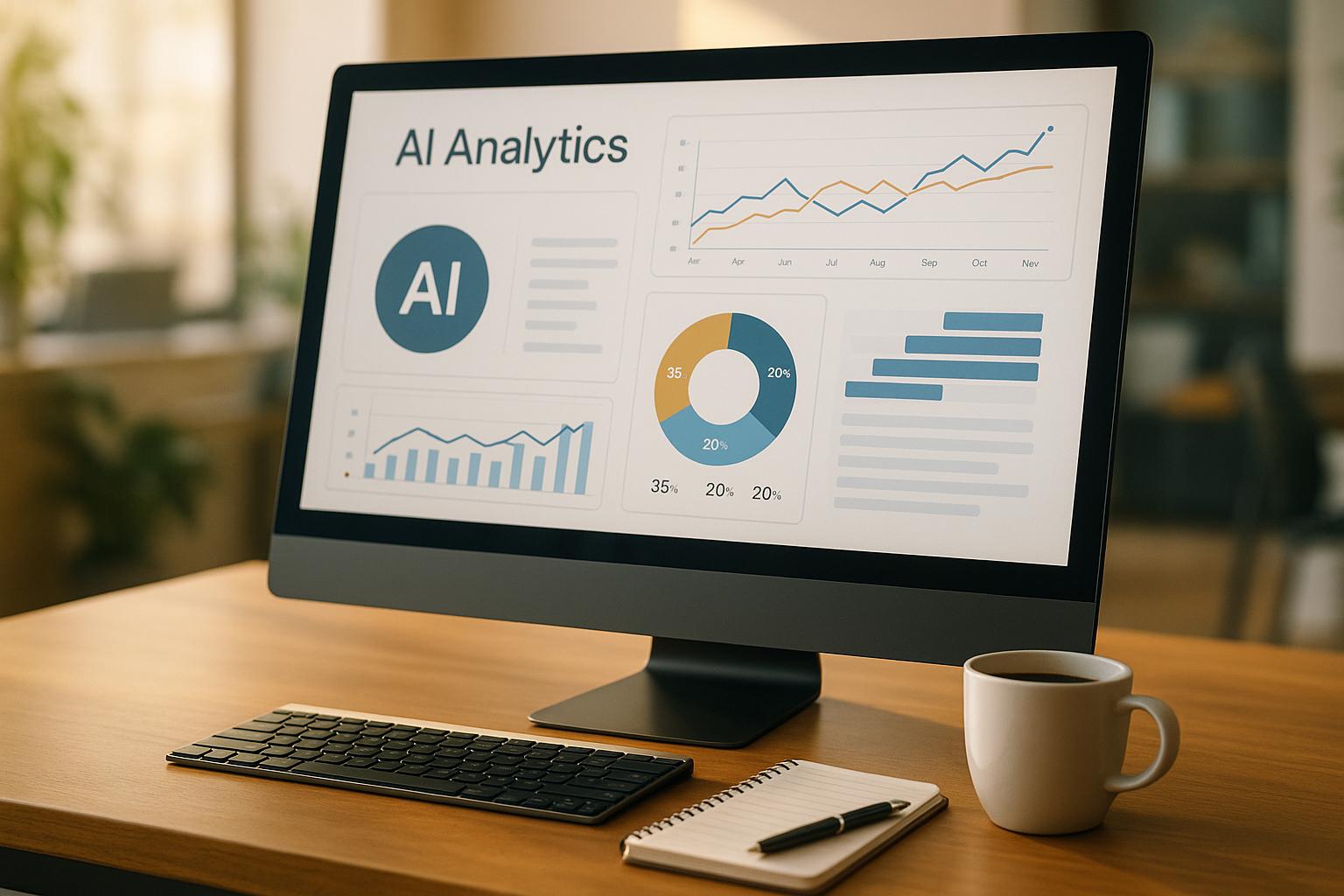AI is transforming how small and medium-sized enterprises (SMEs) handle regulatory compliance, making it easier, faster, and more accurate. Here’s how AI helps:
- Automates Compliance Tasks: AI tools monitor regulations, assess risks, and analyze documents, reducing manual errors by 35%.
- Saves Time and Money: Continuous updates and predictive insights cut costs and improve efficiency.
- Improves Accuracy: AI enhances precision in compliance processes by 40% and reduces false positives by 90%.
- Simplifies Risk Management: AI links risks to controls, enabling proactive compliance strategies.
With tools like Compliance.ai and Centraleyes, SMEs can achieve compliance standards previously reserved for large corporations - all while staying within limited budgets. AI is no longer a luxury; it’s becoming essential for cost-effective, reliable compliance management.
How AI Works in Regulatory Tasks
AI Functions in Regulatory Management
AI simplifies compliance by automating data analysis and decision-making processes. It scans vast amounts of regulatory data to detect patterns and flag violations that might otherwise go unnoticed. For example, Compliance.ai uses machine learning to track regulatory updates from multiple sources and align them with internal policies .
Here’s how AI operates in regulatory management:
| Function | How It Works | Impact |
|---|---|---|
| Regulatory Monitoring | Tracks regulatory changes across jurisdictions | Cuts down on manual oversight |
| Risk Assessment | Links risks to controls within frameworks | Removes the need for manual research |
| Document Analysis | Reviews and processes compliance documents | Boosts accuracy by 40% |
| Alert Generation | Flags compliance gaps and violations | Reduces false positives by 90% |
"Most solutions in the market today are not scalable and still rely on a pull of regulatory content across a multitude of sources, rather than a 'push' of information from a single, reliable source. This is the key value Compliance.ai delivers for banks."
These automated tools provide a strong foundation for improving compliance, especially for small and medium-sized enterprises (SMEs).
AI Advantages for SME Compliance
AI’s capabilities translate into clear benefits for SMEs managing compliance. For instance, Centraleyes has developed an AI-powered risk register that enhances risk management processes .
Some of the key benefits include:
- Improved Accuracy: AI reduces human errors by 35% and enhances process precision by 40% .
- Cost Savings: With the RegTech market expected to grow at a 36.7% CAGR from 2024 to 2033 , AI solutions are proving to be cost-effective.
- Ongoing Monitoring: AI ensures continuous updates, as noted by Ileana Falticeni, Chief Legal Officer at Quantcast:
"Compliance.ai's platform is incredibly helpful for contextualizing the vast amount of daily regulatory updates into actionable insights, and customizing my content feed, so I have focused and timely information on all the regulatory changes relevant to my business."
SAS Compliance Solutions also highlights AI’s versatility. Their SAS Viya platform supports compliance efforts across industries like banking, insurance, and healthcare, helping businesses maintain strong compliance frameworks .
Leverage AI for Enhanced Regulatory Compliance Management
3 Steps to Set Up AI for Regulatory Tasks
Using AI for regulatory compliance can simplify processes and improve efficiency. A 2022 Compliance Risk Study by Accenture found that 95% of businesses are working toward compliance-focused cultures . Here's a straightforward guide to integrating AI into your compliance workflows.
1. Pinpoint Workflow Challenges
Take a close look at your current workflows to spot inefficiencies. Here's how AI can help address common problem areas:
| Problem Area | Impact | How AI Helps |
|---|---|---|
| Data Entry | Errors and wasted time | Boosts accuracy and speed |
| Delayed Reporting | Missed deadlines | Enables real-time updates |
| Risk Assessment | Reactive instead of proactive | Offers predictive insights |
| Compliance Monitoring | Limited scope of oversight | Provides ongoing tracking |
With the compliance software market expected to hit $7.1 billion by 2032 , it's clear businesses are turning to automation to address these challenges.
2. Choose the Right AI Tools
Pick tools that align with your specific compliance needs. For smaller businesses, resources like the AI for Businesses directory can simplify the selection process. Focus on these key factors:
| Criteria | What to Consider | Priority Level |
|---|---|---|
| Integration Capability | Works seamlessly with current systems | Must-have |
| Data Security | Strong encryption and access control | Essential |
| Scalability | Supports future growth | High |
| User Interface | Easy to use with minimal training | Medium |
| Vendor Support | Quick responses and helpful resources | Important |
Involve both IT and compliance teams to ensure the tools meet technical and regulatory requirements.
3. Integrate AI into Existing Systems
Introduce AI gradually to avoid major disruptions. For instance, one company used a phased approach to predict emissions based on production data.
Key steps for integration:
- Start Small: Test AI in one compliance area first.
- Ensure Data Quality: Conduct data audits to clean and validate information.
- Secure Integration: Use encryption and APIs to connect with legacy systems while safeguarding data .
A medical device manufacturer applied AI to analyze compliance with ISO 13485 standards. This reduced risks and helped them avoid costly product recalls .
sbb-itb-bec6a7e
Main AI Tools for Regulatory Tasks
Navigating compliance requires advanced AI tools capable of handling complex tasks.
AI Tools for Risk Prediction
IBM Watson simplifies compliance through transparent and clear AI systems . SAS Viya provides tailored compliance solutions for industries like banking, insurance, healthcare, and manufacturing. Key features include:
| Feature | Benefit | Application |
|---|---|---|
| Predictive Analytics | Identifies risks early | Pinpoints potential compliance issues proactively |
| Real-time Monitoring | Ensures constant oversight | Tracks regulatory updates and monitors compliance status |
| Industry-specific Models | Tailors compliance efforts | Focuses on regulatory needs unique to each industry |
These tools help organizations anticipate and manage risks, laying the groundwork for smoother compliance processes.
AI for Regular Compliance Tasks
Platforms like AuditBoard and Kount focus on automating routine compliance tasks. AuditBoard's AI streamlines workflows and creates compliance documentation . Kount, now part of Equifax, uses machine learning to enhance fraud detection and meet regulatory standards.
Centraleyes stands out with its AI-driven risk register, which links risks to controls within specific frameworks. This eliminates manual research and improves accuracy .
"Every word makes a difference in regulatory compliance ... so how it applies is very specific to your organization. Having Compliance.ai's software definitely makes my job more efficient."
– Kelly Housh, Consultant, Bremer Bank
Choosing the right tool is essential for leveraging these capabilities effectively.
Where to Find AI Tools
Carefully assess AI compliance tools to match your organization’s needs. AI for Businesses offers a curated directory of solutions designed for SMEs and growing companies, helping them find tools that suit their compliance goals and budgets.
Compliance.ai is a standout example of modern regulatory technology. Its platform monitors updates, aligns changes with policies, and tracks implementation.
"The platform is easy to use and it provides comprehensive coverage of regulatory topics relevant to our bank. It's a pleasure working with Compliance.ai; they provide helpful support and continually enhance the platform to make it easier to use and to increase coverage."
– Charlie Christ, Bank of Marin
For SMEs with limited budgets, these tools provide accurate, automated solutions to complex compliance challenges. Federal agencies, such as the SEC for fraud detection and DHS for supply chain monitoring, are also turning to AI for enforcement . With US firms spending 1.3% to 3.3% of their total wage bill on compliance , AI automation is becoming essential for cost-effective management.
These AI tools collectively offer powerful options for streamlining regulatory compliance.
Tips for AI Compliance Management
Managing AI compliance effectively requires constant monitoring and a clear plan for growth. With U.S. AI regulations increasing by 56.3% in the last year alone - from just one in 2016 to 25 in 2023 - staying ahead is more important than ever.
24/7 Compliance Monitoring
Modern AI systems, when set up properly, can monitor compliance around the clock.
| Monitoring Component | Purpose | Implementation Strategy |
|---|---|---|
| Real-time Alerts | Notify immediately of compliance issues | Use dashboards with real-time metric triggers |
| Data Privacy Controls | Safeguard sensitive data | Apply strong security measures for large datasets |
| Performance Tracking | Measure system effectiveness | Use automated drift detection and low-latency monitoring |
Comprehensive documentation and audit trails are essential tools for this process. The rising costs of financial crime compliance highlight this need, with U.S. and Canadian organizations reporting a 13.6% jump to $57 billion in 2022 .
In addition to monitoring, organizations must plan ahead to ensure their compliance strategies can grow and adapt.
Planning for Growth
While continuous monitoring protects current operations, preparing for the future requires training, regular risk assessments, and staying aligned with regulatory changes. A Deloitte survey revealed that only 25% of leaders feel their organizations are well-prepared to manage governance and risk issues tied to Gen AI adoption .
Here are some steps to strengthen your AI compliance system:
- Ongoing Staff Training: Only 6% of organizations currently train all relevant employees . This needs to change.
- Regular Risk Assessments: Evaluate AI systems routinely using a strong risk management framework.
- Stay Updated on Regulations: Engage with regulators and adapt to new governance requirements .
"The aim of the new rules is to foster trustworthy AI in Europe and beyond, by ensuring that AI systems respect fundamental rights, safety, and ethical principles and by addressing risks of very powerful and impactful AI models." - European Union
For a solid starting point, organizations can refer to the National Institute of Standards and Technology's Artificial Intelligence Risk Management Framework .
Conclusion
AI is reshaping how SMEs manage regulatory compliance, offering tools that range from automating risk assessments to real-time monitoring. With the complexity of U.S. regulations , these AI-powered solutions help businesses maintain reliable compliance systems.
The benefits are clear. Companies using AI-driven compliance tools have reported cutting lost sales down to 2.3% . Platforms like AI for Businesses offer tools tailored for SMEs, including automated monitoring and risk assessment systems, making compliance more manageable and efficient.
"While we like to refer to AI as more evolutionary than revolutionary in the world of tax and compliance, there is no denying its impact and importance ... using predictive analytics to anticipate changes has become an essential part of our business" - Alice Katwan, President of Revenue at Sovos
AI tools like Centraleyes' risk register and Compliance.ai's monitoring system are paving the way for smarter compliance management . These solutions simplify the process and adapt to changing regulations, helping businesses stay ahead. Leveraging AI can transform how compliance is handled and support long-term business success.


